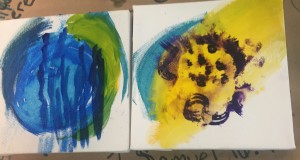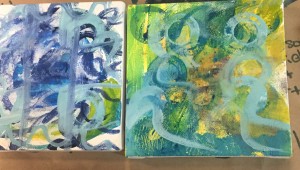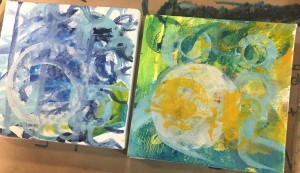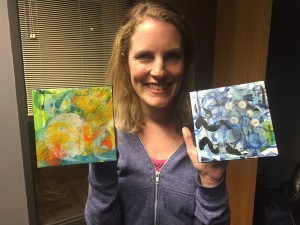Visual art has never come to me intuitively, the way writing has, though I don’t think I can attribute this entirely to my eyesight. I’ve met talented artists who are legally blind and still have a strong sense of spatial awareness on paper, and there are artists who are color blind who use brilliant color schemes. For me, however, any type of art class has always felt like a foreign land in which I don’t understand the cultural norms.
So I surprised myself a bit when I signed up to take a painting class.
Painting is one of those visually artistic activities I have always avoided, thinking I would never be able to do it remotely well, much less enjoy it. Friends have invited me to places like Pinot’s Palette, and I have always found excuses not to go, as the idea of trying to mimic a specific scene, animal or person on canvas sounds impossibly frustrating. But when I noticed that Maureen, a talented artist from our church, was teaching an abstract painting class, a curious inkling sparked, and I had the urge to sign up.
When I sat down in Maureen’s class last week with two blank canvases in front of me, I felt a little adrenaline rush, imagining the splashes of color that would soon occupy the white space.
“I want you to think of a thought that you love…could be a place that makes you happy, or maybe a scene,” began Maureen.
I immediately pictured a meditation I had done earlier in the day, during my Kundalini yoga class. The meditation was on dying and new life, which felt very fitting during this season of lent and Easter, along with the endings and beginnings ahead of our family with our big move from Illinois to California. I usually get distracted during guided meditations, but I seemed to melt away in this particular one.
(abbreviated here)…..`“Now visualize two sides: one is warm and cozy; the other is very icy and cold. Start walking toward the dazzling icy pathway, a winding pathway going through the hills, an absolutely dazzling light and snowy atmosphere. Dazzling snowy pathway is the pathway to the heavens; start moving through it, passing through the winding, dazzling path, freezing, snowy, windy path. Keep going; don’t stop. Feel no physical senses or contact, move as a transparent body. You are transparent body in the beginning; transform yourself into a transparent body now. Go through the penetrating body and walk through this valley of dazzling light, leaving behind the coziness of senses. Leave behind the coziness of senses. Let it go. Let the opaqueness go.” – Yogi Bhajan
“I want you to envision this thought as you paint,” Maureen continued. “Most of what you do tonight should be out of emotion and intuition, though I will teach you some basic artistic concepts as well.”
I decided to use the 2 blank canvases to paint the two sides depicted in the mediation— the darker, cooler side and the shining, dazzling light.
Maureen explained some basic art concepts to get us started, such as the rule of thirds, layering and fluidity. She showed us how to lift and blot color out using drops of alcohol and paper towels. She had tons of fun tools for us to try, from stencils to stampers to paint pens, and lots and lots of brushes in all shapes and sizes (even toothbrushes!). Maureen kept stressing the importance of using our emotions and intuition as primary tools, however.
“As you choose your colors, go toward what you’re drawn to, but don’t spend too much time debating. The key tonight is not to overthink anything.”
Uh oh. Overthinking is my thing. It’s how I operate. It actually aides me in creating characters and scenes and editing plot lines as I write. I didn’t like the thought of giving it up for an entire evening, but I decided to give it a try.
I had many images and colors in my mind when I began, and could picture the essence of what I wanted to paint, including swirls in hues of dark blues and purples on one canvas, and warm, bright tones to depict dazzling light on the other. But as I began dipping various brushes in the acrylic drops of paint, stroking the canvas at random places, nothing appeared as it did in my mind, not by a long shot.
My canvases resembled something my 2-year-old nephew painted in preschool. 
That old, familiar sinking feeling formed in my gut as I attempted to peek at my classmates’ work, positive that everyone else was painting masterpieces. I couldn’t really make out much, but the blur of color combinations alone looked far more advanced than the mess that appeared in front of me. I tried to make shades of aqua and a burst of yellow but ended up with a globs of blue pooling in the middle of one canvas and smudges of green on the other.

And even though I couldn’t really see my classmates’ progress, I could hear it in their conversations with Maureen.
“I’m thinking I need some more movement over here,” one person observed. They went on to converse about flow and tension and pigments and impressions and gesso. I had no idea what these terms meant in the context of painting, especially not in the context of whatever strange thing I was painting. All I knew was that I felt tense at the thought of trying to create tension in my painting, whatever that meant.

I think Maureen could sense my frustration, possibly because I hung my head and whined “i’m so frustrated! Nothing is turning out how I picture it in my head!”
Maureen, however, did not seem phased by this melancholy artiste. All part of the process, apparently.
She seemed to realize, even before I did, that my blockage stemmed from not being able to easily locate the tools I needed. I’m not sure why, but I really hadn’t considered the stress involved in quickly locating brushes, paints and tools while painting when you have 4 degrees of vision.
The craft of writing has far less tools to begin with, but the few that it does have offer me far more familiarity. My fingers dance nimbly across my laptop’s keyboard, and I can easily use a thesaurus or reference quotes from books. The clunkiness with which I reached for the alcohol dropper or fumbled to wash and dry my brushes between colors seemed to slow my process down immensely.
Maureen patiently offered me more tools and techniques, placing tools in my hand or directing me where to find items. She mixed a couple colors on my palette to create the colors I was describing and showed me the areas where I needed more patterns or movement or color.
I dabbled here and there and got a little more adventurous with splashes of color and stencils. 
I began to like where my painting was headed, at least the canvas on the right anyhow.

At a certain point, I knew it was finished, and I proudly marched into my husband’s office at church, where he was finishing up some work, and held up my paintings. I knew they weren’t masterpieces by any means, but they were a darn good first try.

The experience of painting made me think about the parallel between art and life, and how when we have blockages in life, it’s often because we don’t have the tools we need. Whether mobility or otherwise, it’s the accessibility of tools like canes and guide dogs and technology that allow us to move forward.
When we have tools readily available to us, we can make masterpieces out of our lives. Or at least some pretty darn good tries.

This is wonderful. Thanks Joy. You rock!
Thank you for the great class, Maureen!
Very well written and thought provoking. Thank you.
Thank you!